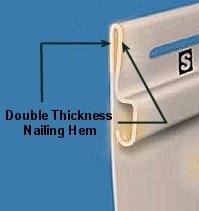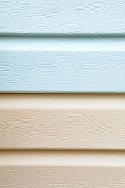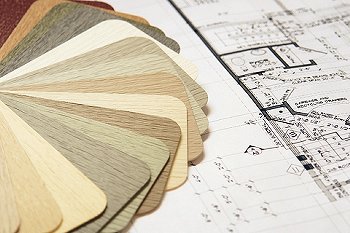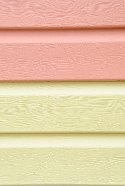Choosing Vinyl House Siding
Vinyl house siding can be an economical and low-maintenance choice for cladding the exterior of your home. It's available in a number of different profiles that encompass virtually all of the traditional types of wood siding such as clapboard, shake and board-and-batten. But vinyl siding goes beyond that, with styles that mimic the look of stone, brick and log siding.
Considerations include whether or not to select standard vinyl siding or the insulated variety which adds both efficiency and durability benefits.
Color is another factor to consider because once you choose a color there's really no turning back since vinyl siding doesn't offer a practical surface for painting.
There are also different grades of vinyl, each with their own price point. Cheaper vinyl may cost less but it can also look cheap too. Premium vinyl siding offers better quality but may ultimately cost as much as other non-vinyl siding choices. The environmental aspect of vinyl is another consideration with advocates on both sides of the "green" debate.
Whether or not to choose vinyl house siding comes down to your preferences and valuation of what vinyl can provide in the way of maintainability, looks, cost and durability.
What Should I Know About Vinyl House Siding?
Becoming familiar with vinyl siding is your first step toward making a more informed decision about whether it's going to be the right choice for your home. You'll want to get to know the various styles and forms that are available and the options you can choose from.
Vinyl Siding Styles And Forms
Most vinyl siding is made to resemble types of siding that originated with wood. The most common is probably the clapboard or lap siding profile.Typical Horizontal Vinyl Siding Terms
Image Courtesy of CertainTeed Corp.
Lap style siding is available in single, double and triple "courses". Courses are the rows that represent wood boards in a single piece of vinyl siding.
The important part to remember about the length of the siding is that it will affect the number of seams that are visible on your house.
Typical lengths are 12 feet long however 16 and 20 foot lengths are an option. But before you decide that 20-foot vinyl siding is the way to go, remember that the longer the siding piece, the more flexible it is. To counter this flexibility better vinyl is thicker and has heftier flanges and nailing hems which helps it stay more rigid. A good installation job is also key to avoiding waviness when using long siding pieces.
Vinyl Board & Batten Siding
Photo Courtesy of CertainTeed Corp.
Vertical siding is another option with vinyl. A common variety is the board-and-batten style which uses vertical "boards" accentuated by narrower battens, also oriented vertically.
Polymer Shakes
Photo Courtesy of CertainTeed Corp.
The look of wood shakes is one more vinyl option with a number of style choices available. Polymer vinyl shakes are molded from polypropylene resin in a different process than what's used to make clapboard vinyl pieces.
The molding process used to make the shakes allows the manufacturers to achieve deeper grooves in the material resulting in a more convincing look. As a result molded vinyl shakes are thicker than standard horizontal vinyl siding.
In addition to the siding itself there are multiple selections of trim pieces you can choose. In fact a wise selection of trim can sometimes do a better job camouflaging the fact that a house is sided in vinyl. That's because some of the more detailed and substantial trim options do a better job of looking like wood trim. Examples include fluted corner posts, window and door mantels, dentil moldings, window crowns and rosettes.
Trim options also offer more design flexibility when it comes to creating or maintaining your home's architectural style, be it Georgian, Queen Anne, Victorian, Federal or Cape.
Insulated Vinyl Siding
Insulated vinyl siding is backed with a layer of insulating foam material. It can be fused to the back of the vinyl or it can come as a separate molded piece that's installed behind the siding. Photo Courtesy of CertainTeed Corp.
Photo Courtesy of CertainTeed Corp.
The main benefit is that it increases the exterior wall's insulation, making your home a bit more energy efficient.
Typical R-values (R-value being a measure of thermal resistance) for insulated vinyl house siding are around 4. It might not sound like much but that could mean about a 20% to 25% increase in your exterior walls' efficiency if they have an R-value of about 20 to start with (assuming 2x6 stud construction and fiberglass batt insulation). Keep in mind you'll pay more for insulated vinyl siding.
Another benefit of the insulated variety is that it's more durable since the foam backing provides some resistive force against impacts.
It also can make the vinyl siding's appearance more realistic because it "fills out" the profile. A lot of the clapboard style of vinyl siding, particularly thinner products, have a concave profile which doesn't resemble wood and is a visual giveaway of vinyl siding.
Certified Products And Installers
If you're the type that feels better if the products and services you employ have some standardization and regulation behind them, then you'll be glad to know that vinyl house siding hasn't been left out.The Vinyl Siding Institute, the trade organization supporting vinyl siding manufacturers and installers, sponsors a vinyl siding product certification program. Through this program various vinyl siding products can be certified by an independent third-party organization. Certified products meet quality criteria established by the ASTM (American Society for Testing and Materials).
The 3 ASTM standards that might be of relevance to any homeowner considering vinyl house siding are the following:
- General quality standards for vinyl siding (ASTM D3679)
- Color retention standards for vinyl siding (ASTM D6864)
- Certification of vinyl siding installers (ASTM D4756)
The point here is that there are standards established to ensure quality vinyl siding products and installations. If you're concerned about inferior products or shady installers, you can check the VSI website to see which products are certified as well as which installers (by U.S. state or Canadian province) are certified.
If you really want to get technical and delve into what these standards are all about, simply put the ASTM number into a search engine (for example, 'ASTM D3679'). What you'll get is the ASTM specification along with it's summary. If you want to read the full specification you'll need to buy it from the ASTM.
Pros And Cons of Vinyl Siding
A great attribute of vinyl house siding is it's low maintenance requirements. However along with that feature there are some drawbacks too. Here's a list of vinyl siding pros and cons.
The Pros....
- Low Maintenance
Vinyl house siding is a low-maintenance cladding. There's no need to scrape and reapply paint nor any need to caulk joints. A wash with a hose is the most maintenance you'll probably encounter with vinyl. - Reasonably Good Durability
It's a relatively durable product, particularly if it's on the thicker end of the product spectrum and even more so if it has an insulation backing. Vinyl won't rot like wood and wood-based products can, is non-porous and isn't threatened by pests like insects or woodpeckers. - Economical Compared To Other Siding Choices
Vinyl can be an economical siding option particularly compared to other choices like brick, stone or wood. Keep in mind however that more premium vinyls will cost more than the lower grade versions. If you need cost data for comparison purposes to help make choices, getting estimates from vinyl siding professionals can be a good start. - Decent Color Selection
The range of available vinyl siding colors is fairly broad and different manufacturers will have their own selections. Your choices aren't infinite like you'd get with a paintable option but you're not just limited to a palette of several colors. - Greater Dent Resistance Than Aluminum
Vinyl's flexible nature allows it to absorb impact better than more malleable materials like metal which can dent if struck hard enough. Given reasonable care and with some luck from Mother Nature (like no violent hailstorms) vinyl siding can last for years. - Numerous Styles/Profiles
Vinyl house siding is readily available in virtually any profile (style) of siding that's available with wood. Whether you like the look of cedar shake, wide or narrow clapboard or vertical siding you can find it in vinyl siding. - Installation Is (Relatively) DIY-Friendly
It's a type of siding that you can install yourself, with some time and a few handyman skills. Getting a quality installation with minimal seams and no sags is probably best assured with a qualified professional installation but a self-installation is not out of the realm of possibility.
...and the Cons...
- Not Indestructible
Although it has some flexibility vinyl siding will crack if it's hit hard enough, more so if it has no backing. That tendency gets magnified when its cold. Vinyl can also melt. More than one homeowner has located the BBQ grill too close to the side of the house and ended up with warped and melted siding (yes, that really does happen). - Not Fireproof
Because it's not fireproof vinyl house siding isn't a good option in locations that are prone to seasonal brush fires and wildfires. The heat generated by close proximity to fire and the combustible nature of vinyl make it a hazardous choice in risky locales. - No Easy Color Change Flexibility
Vinyl offers no option to change the color of your house, save for re-siding in another material/color. If you're not someone who will be content with your color choice 10 years later, you don't have easy options to change the color. - Seams More Noticeable Than Other Siding Types
Seams are visible and while other types of siding have seams, vinyl siding seams can be more noticeable because the pieces overlap, unlike other types of siding like fiber cement and wood that have butt joints. - Readily Expands & Contracts
Vinyl siding readily expands and contracts with temperature making good installation techniques a must for good looking siding. If the siding isn't installed correctly (not enough gaps at the end of a course or excessively tight nailing) the siding can warp and buckle because it isn't allowed to "move" with the temperature. - Risk Of Fading
Vinyl siding can fade in sunlight. Now before we condemn vinyl siding for good, understand that paint fades too and that there are standards established to minimize fading and extend the life of your vinyl's color (shame on you if you didn't read that above). The key point here is that if you do get fading over time, it's not as easy to fix as just slapping on a fresh coat of paint. - Limited(??) Color Selection
Yes, it was mentioned as a "Pro" above but color selection can also be a drawback. There could be 20 or 30 colors in a manufacturer's lineup but what if it's not the exact shade of khaki you're looking for? There are all sorts of neutrals and earth-tone vinyl colors out there but they also might not be the exact shade you want on your house. That 'slate gray' might have too much blue in it or the 'taupe' color choice might be a bit on the pink side. - Cheaper Quality Usually Looks...Well...Cheap
Lower quality vinyl siding and poor installations can look cheap. Vinyl might offer a means to cover your house but the adage 'you get what you pay for' applies here.
What To Look For
So let's say you understand what vinyl house siding is all about and you're familiar with their high and low points. If you're going to choose vinyl, here's what you should look for.
- Product Thickness
Thicker products are more rigid and robust and will stand up to knocks better than thinner products. Average vinyl siding thickness is about 0.045" thick with thinner versions around 0.040 and thicker products at 0.054" thick. Image Courtesy of CertainTeed Corp.
Image Courtesy of CertainTeed Corp. - Double Nailing Hem
Double hems make the panel more rigid and less prone to sagging and flexing and also offers greater resistance to failure from high winds. - Deeper Lap Profiles
Deeper profiles (also known as panel projection) on lap style siding provide bolder shadow lines offering a more convincing look of real wood. Manufacturers usually provide panel projection dimensions in their product information/specifications. Usually the better the grade of vinyl siding product the deeper the panel projection. - Certified Siding/Installers
At a minimum certified products and installers have met a certain threshold of standards aimed at achieving and maintaining a higher level of quality and performance. - Foam Backing
This makes the panel more durable, offers some insulating value and can enhance the panel's appearance, particularly in clapboard styling by giving it a flatter, more realistic look. - Wind Speed Rating
Wind speed rating represents the ability of the vinyl house siding to withstand high winds without blowing off. The higher the rated speed the more effective it is at staying in place at those higher wind velocities. - Longer panels
Longer panels at 16, 20 or 25 feet offer fewer seams than typical panels that are about 12 feet long. - Installer Experience
Look for installers that have plenty of experience with vinyl siding and if possible, the brand of vinyl you want. Get references and research their previous jobs.
A Word About Vinyl Siding Colors
Vinyl siding colors are probably the next most fretted-over consideration after the style and cost issues.

Vinyl siding colors are typically offered in a range of neutrals and tones that are common among house colors. The quantity of colors will differ based on the manufacturer of the siding. If you prefer earth-tone neutral colors there tends to be a sufficient amount of overlap with regard to vinyl color choices among manufacturers. In that sense you're not locked in to a particular make of vinyl siding.
Darker, richer vinyl colors do exist but they're not as plentiful. Manufacturers like KP Building Products offer the Norman Rockwell™ line of vinyl house siding that's offered in vibrant colors like deep barn red and dark ocean blue. If you want these kinds of vinyl siding colors, you'll have to shop around for the manufacturers that offer these shades.

Beyond color choice the next issue to consider is fading. The effects of sunlight and the environment on vinyl siding colors won't be cured but the technology has come a long way. According to a Consumer Reports test on vinyl siding the resistance to fading has made great strides.
That fact is corroborated by the vinyl house siding manufacturers' warranties against excessive color fade. However the criteria used to evaluate fading is a bit complex, quoted in terms of "Hunter units of delta E."
"Hunter units" is a reference to the measurement scale developed by the laboratory specializing in measuring color as seen by the human eye. So while it's true that manufacturers warrant against excess fading it's questionable how easy it would be to prove any fading occurred. Hopefully, you won't have to.

The final point on vinyl siding color is on the question of whether or not it can be painted. You'll find information on the web and DIY procedures that suggest it's possible to paint vinyl siding but in reality, it's not a slam-dunk.
Vinyl by nature expands and contracts a lot and whatever paint is applied has to move with it. But there aren't many paints that can tolerate this and those that don't will crack and peel. Some materials are just better than others, being more stable with less "movement". Vinyl isn't one of them. So painting vinyl is probably best described as 'not practical'.
Finding A Local Vinyl Siding Source & Free Estimates
At this point you might think that vinyl siding is the right choice for your house. The only other questions have to do with who can install it for you and how much it's going to cost.
If you need some help in that area and would like to find local vinyl siding professionals, take a moment to fill in the form below. It will allow you to find local vinyl siding contractors who will contact you at your convenience and provide free, no-obligation quotes to install vinyl siding on your home.
It's just a bit easier to have local sources come to you rather than having to look for them yourself.
Here's More Related Info That Might Be Helpful...
Choosing House Siding - Discover the various types of siding available for your home and the pros and cons that each offers.
Fiber Cement Siding - Fiber cement siding has a lot going for it including durability and longevity. Find out what's available and how to choose in this article.
